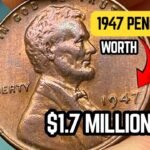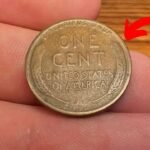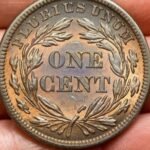Let’s be honest—most of us don’t give a second thought to the pennies jingling around at the bottom of our purses or hiding between car seats. They’re just tiny bits of copper, right? But what if one of those unassuming coins was secretly worth thousands—or even close to a million dollars? That’s not just wishful thinking. For savvy coin collectors and lucky treasure hunters, the Lincoln Wheat Penny has proven to be one of the most unexpectedly valuable coins in American history.
Some versions of this iconic coin have sold for as much as $960,000, turning everyday pocket change into a financial windfall. And the best part? There’s a chance you could still find one in circulation today.
Let’s explore what makes the Lincoln Wheat Penny so special, the rarest types you should be hunting for, and how to tell if you’re sitting on a small fortune disguised as a one-cent coin.
What Is the Lincoln Wheat Penny?
The Lincoln Wheat Penny—often simply called the Wheat Cent—was first minted in 1909 and remained in production until 1958. It was introduced to commemorate the 100th anniversary of Abraham Lincoln’s birth and became the first U.S. coin to feature a real person.
The obverse side shows the familiar profile of President Lincoln, while the reverse design features two stylized wheat stalks encircling the words “One Cent” and “United States of America.” This distinctive wheat design is what gave the coin its nickname and sets it apart from later Lincoln Memorial or Union Shield pennies.
Although most of these pennies are only worth a cent or two, certain rare and error-filled versions have become highly desirable among collectors—and in some cases, they’ve fetched life-changing sums at auction.
Why Some Lincoln Wheat Pennies Are So Valuable
Not all Lincoln Wheat Pennies are created equal. While millions were minted over the years, a handful of them are far more valuable than the rest due to low mintage numbers, unique errors, or historical significance. These standout coins are what collectors dream about.
Take, for example, the famous 1909-S VDB. This coin was among the first ever minted in the Lincoln Wheat Penny series. It was produced in San Francisco and features the initials of the designer, Victor David Brenner (VDB), on the reverse side. Only 484,000 were made before public backlash over the visible initials caused the Mint to pull the design. That combination of rarity and historical context has pushed its value up to an astonishing $960,000 in pristine condition.
But the 1909-S VDB isn’t the only Lincoln Wheat Penny with a jaw-dropping price tag. Let’s take a look at some of the other rare and valuable varieties you should be on the lookout for.
Key Rare Lincoln Wheat Pennies to Watch For
| Year | Mint Mark | Why It’s Valuable | Estimated Value Range |
|---|---|---|---|
| 1909-S | S (San Francisco) | First year of issue, low mintage | $1,000+ |
| 1909-S VDB | S (San Francisco) | Designer’s initials, extremely limited | $600 – $960,000+ |
| 1914-D | D (Denver) | Rare due to limited surviving specimens | $200 – $10,000+ |
| 1922 No D | (No mint mark) | Minting error, rare find | $500 – $50,000+ |
| 1955 Double Die | (Philadelphia) | Notable misprint causing doubled letters | $1,000 – $100,000+ |
Each of these coins has a unique story and rarity factor that makes it valuable. Some were minted in small numbers, while others have intriguing flaws or historical appeal. Regardless of the reason, these special editions of the Lincoln Wheat Penny have become legends in the world of numismatics.
Could a Rare Lincoln Wheat Penny Still Be in Circulation?
Believe it or not, yes—rare Lincoln Wheat Pennies can still be found in circulation. While the odds are low, they’re not zero. Old coins often find their way into the change stream through estates, forgotten collections, or people who simply don’t realize what they have.
Here are a few common places where these hidden treasures are most likely to show up:
- Bank Coin Rolls: People regularly return coin jars to banks, and rare coins can end up in rolled coins by mistake.
- Estate Sales or Inherited Collections: Many folks inherit old coin collections from family members and have no idea what’s in them.
- Everyday Change: While rare, there have been documented cases of collectors discovering valuable Lincoln Wheat Pennies in everyday transactions.
- Garage Sales or Flea Markets: Sometimes people unknowingly sell rare coins for face value among other old items.
So yes, it’s entirely possible that a coin worth thousands—or even that legendary $960,000—might be hiding in plain sight.
How to Tell If Your Lincoln Wheat Penny Is Valuable
Not sure what to look for? Here’s a quick checklist to help you determine whether your penny might be a rare treasure:
1. Check the Date and Mint Mark
Start by looking at the date on the front of the coin and the mint mark just below it. Key years like 1909, 1914, 1922, and 1955 are worth investigating. Mint marks can be “D” for Denver, “S” for San Francisco, or no mark for Philadelphia. Coins from San Francisco are generally more scarce.
2. Look for Errors or Oddities
Many high-value Lincoln Wheat Pennies are valuable because of unique errors. The 1955 Double Die is a great example, where the lettering appears doubled. Other errors include missing mint marks, off-center strikes, or die cracks.
3. Compare with Known Rare Coins
Familiarize yourself with the most famous rare wheat pennies so you know what to look for. Many online guides, numismatic books, and forums offer side-by-side comparisons.
4. Assess the Condition
Grading matters—a lot. A coin in mint or near-mint condition can be worth significantly more than the same coin that’s been heavily circulated. Coins are graded on a 70-point scale, with MS (Mint State) grades at the high end.
Where to Sell a Valuable Lincoln Wheat Penny
If you think you’ve hit the jackpot and found a rare Lincoln Wheat Penny, it’s important to sell it through the right channels to get maximum value. Here are a few solid options:
- Reputable Coin Dealers: Local coin shops can provide appraisals, but always get a second opinion.
- Online Auction Platforms: Sites like eBay or Heritage Auctions have a large collector base and competitive bidding.
- Coin Shows and Conventions: These events bring together experts, dealers, and collectors who can help you accurately price and potentially sell your coin.
- Third-Party Grading Services: Before selling, consider having your coin professionally graded by companies like PCGS or NGC. A certified grade can dramatically increase your coin’s credibility and value.
Frequently Asked Questions About Lincoln Wheat Pennies
Q1: Are all Wheat Pennies valuable?
No, the vast majority of Lincoln Wheat Pennies are only worth face value or a few cents. But those from key years or with errors can be extremely valuable.
Q2: How can I store my pennies to preserve their value?
Use coin holders or flips to protect your coins from scratches, dirt, and environmental damage. Keep them in a cool, dry place away from direct sunlight.
Q3: Can I clean my Wheat Penny to make it look better?
Avoid cleaning your coins. Even gentle cleaning can lower their value. Collectors prize original patina and untouched surfaces.
Q4: Is it worth collecting Wheat Pennies as a hobby?
Absolutely! The Lincoln Wheat Penny is one of the most collected coins in American history. It’s an affordable, fun, and potentially profitable hobby.
Final Thoughts: Hidden Riches in Plain Sight?
The Lincoln Wheat Penny is more than just a tiny piece of copper—it’s a fascinating part of American history and a legitimate chance at finding unexpected wealth. While most of them will never be worth more than a few cents, a select few are worth thousands, tens of thousands, or even nearly a million dollars.
So the next time you’re handed a penny in change, don’t be so quick to dismiss it. Flip it over. Check the date. Look for that signature wheat design. You never know—you might be holding a Lincoln Wheat Penny that could change your life.
After all, some of the most valuable treasures are hiding in the most ordinary places. Happy coin hunting!
Some Important Link
| Telegram Group | Click Here |
| WhatsApp Group | Click Here |
| Home Page | Click Here |










